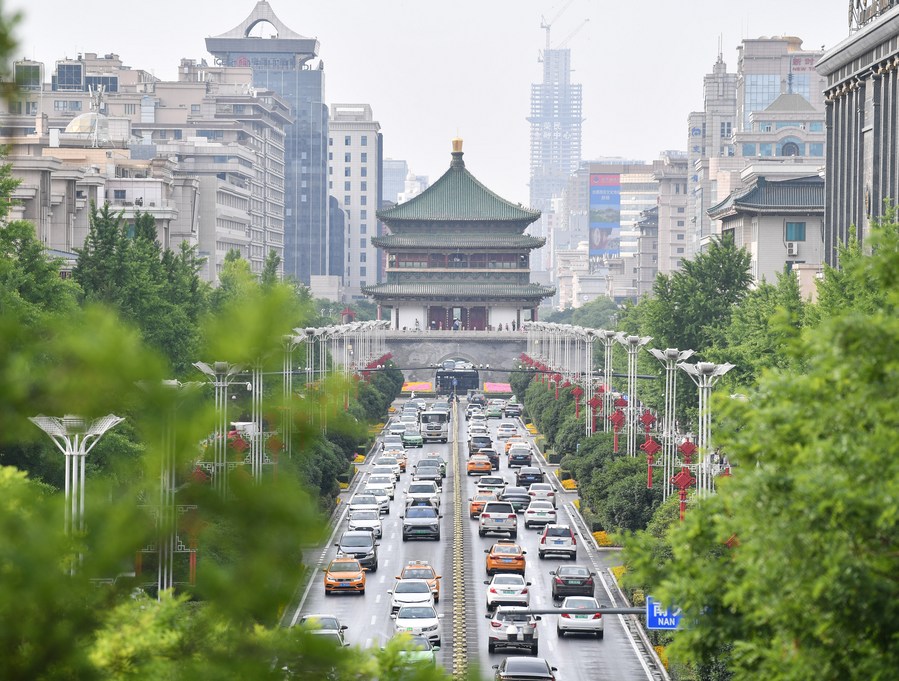
People ride bicycles past electronic billboards displayed around the Bell Tower in Xi'an, capital of northwest China's Shaanxi Province, May 17, 2023. /CFP
People ride bicycles past electronic billboards displayed around the Bell Tower in Xi'an, capital of northwest China's Shaanxi Province, May 17, 2023. /CFP
Editor's note: Momodou Lamin Choi is an award-winning Gambian journalist. He works for Gambia's leading private television network QTV as a senior reporter. The article reflects the author's opinions and not necessarily the views of CGTN.
Just as the world emerges from the devastating impact of the COVID-19 pandemic, global solidarity is required more than ever to tackle challenges and tap into opportunities in multilateral cooperation. Dialogue and consultation are the recipes for finding the path to common understanding, peace, development, and prosperity. What is refreshing to many is China's leadership role and commitment to that spirit right from the onset of the post-pandemic era through massive and multilateral exchanges with diplomatic partners.
The latest round of all is the China-Central Asia Summit. The summit which is held from May 18 to May 19 in Xi'an, China's Shaanxi Province, is the first major diplomatic engagement to be organized and hosted by China this year. In what is a high-level state event, presidents of Central Asian countries and China, including President Xi Jinping, are set to explore opportunities and build stronger cooperation for the common interest of their people.
Bound by geographical proximity and faced with common concerns, China and Central Asian countries have the chance to consolidate their socioeconomic strength to foster peace, stability, and quality development. Analysts see China's involvement in Central Asia as a long-term phenomenon and a turning point in the region's history and economic development. This and other realities make the summit one of the most significant multilateral engagements where state parties will come out of it with a blueprint to refine cooperation in several areas.
Over the years, Central Asian countries have proven to be one of the most important partners with China as they share common interests in the areas of economics, regional security, peace, and development. It is against this backdrop that the people of China and Central Asian countries would look forward to a productive summit where a cooperation blueprint on their common interest is expected to be one of the outcomes.
One of the major topics on the agenda expected in the summit is enhancing economic cooperation. Both China and Central Asian countries have long-existing economic cooperation that has seen consistent progress. According to official data, in 2022, China's trade with Central Asian countries reached $70.2 billion, marking a 100-times increase over the past 30 years since the establishment of diplomatic ties.
In that productive economic cooperation, there are more potential opportunities to further tap into. It is expected that the summit will be a stock-taking moment to identify the strengths and weaknesses of the existing economic cooperation and devise strategies to diversify it into more areas. Along this journey, there are promising prospects of more achievements in the already-strong economic ties between China and Central Asian countries. The six leaders' expressed commitment and determined steps to improve their economic cooperation signal a united front for stronger cooperation.

A view of the Bell Tower in Xi'an, northwest China's Shaanxi Province, May 15, 2023. /Xinhua
A view of the Bell Tower in Xi'an, northwest China's Shaanxi Province, May 15, 2023. /Xinhua
Another highlight of the summit is expected to be centered on the Belt and Road Initiative (BRI). This economic and development initiative by China has had far-reaching impacts around the world, including in Central Asia. The BRI has expanded China's economic, geopolitical, and business presence around the world. It demonstrates China's commitment to playing a significant role in the global economy and governance for a community of a shared future for mankind.
Today, what's important to highlight is that China has successfully sealed the BRI agreement with all the Central Asian countries. Through the BRI, China has been the largest investor in Central Asia. Being where the BRI started in 2013, Central Asia has immensely benefited from its cooperation projects since then, thereby improving trade, mobility, and economic activities in the region. It will be interesting to see how much more the BRI cooperation could further deepen between China and Central Asia.
Furthermore, due to geographical proximity, the success of China-Central Asia cooperation is largely dependent on regional peace and security in the region. In addressing these interests, China has steadily expanded its security engagements in Central Asia through multilateral dialogue on security issues among all ranks of Central Asian leaders including security officers.
Through this collaborative effort, Central Asian countries have benefited from practical actions such as regular military exercises and military-degree training. Over the years, the region has faced increasing security threats such as religious extremism, international crimes, terrorism, ethnic and civil conflicts, border tensions, etc. The summit could trigger more discussions and cooperation agreements on supporting Central Asia to tackle the security challenges for long-term peace and development.
All in all, these opportunities and expectations highlighted herein present a similar cooperation pattern between China and many parts of the world including Africa. After all, China, Central Asia, and Africa are developing countries with some relatively similar socio-economic challenges. The shared cooperation between them creates more opportunities to fulfill their needs and deepen exchanges, thus heading toward the vision of building a community with a shared future for mankind.
(If you want to contribute and have specific expertise, please contact us at opinions@cgtn.com. Follow @thouse_opinions on Twitter to discover the latest commentaries in the CGTN Opinion Section.)